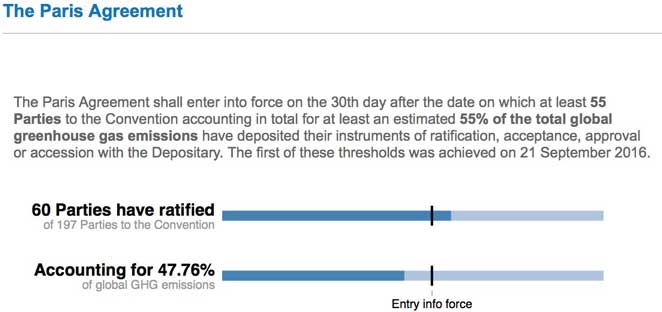
That is not what happened.
Instead a total of 31 nations confirmed their legal commitment, not 20, and the previous total was not 27, but had reached 28 because Ukraine had ratified on 19th Sept.
For the Paris Agreement to enter into force there needs to be at least 55 nations ratifying it (we now have 60 so that is a tick), and also that must all account for at least 55% of the total global greenhouse emissions. We are now up to 47.76%, so this is now within our grasp. It really is …
Video messages from Germany, France, the EU, Canada, Australia and South Korea among others all promised to ratify the Paris accord in the coming months. Should these promises be fulfilled, the agreement will pass the second threshold and come into force.
Australia, one of the largest per capita emitters, will make its “best endeavours to ratify” in 2016, said the country’s prime minister, Malcolm Turnbull. Barbara Hendricks, the German environment minister, said her country planned to ratify the deal “well ahead” of the next UN climate meeting in Marrakesh in November. The UK has made a similar commitment.
Formal UN Announcement on this progress
The Press Release from the UN announcing this progress is found here. Of note within that is the following reality check that clearly and correctly highlights that the Paris Agreement is not a solution, and is instead just a first step towards one …
“The adoption, signing and ratification of the Paris Agreement are wonderful news but by no means the end. Securing a climate-safe world and supporting the realization of the Sustainable Development Goals is a multi-decadal effort of constant improvement. But we are out of the blocks and off down the track with enthusiasm, creativity and determination to make the transformation the people of this world expect and need,”
… and also further on is an outline of what happens once it has actually entered into force …
Entry into force will trigger a variety of procedural activities. For example it will trigger the first Conference of the Parties serving as the Meeting of the Parties to the Paris Agreement or in short the CMA1.
The climate action plans, or Intended Nationally Determined Contributions (INDCs) submitted in the run up to the Paris conference, are transformed into Nationally Determined Contributions (NDCs).
Governments will also be obligated to take action to achieve the two temperature limits enshrined in the agreement—staying well below 2 degrees C and pursuing efforts to limit the temperature increase to 1.5C over pre-industrial levels, this century.
The next key milestone, following ratification and entry into force, is likely to be the swift and successful conclusion of negotiations to develop the rule book that will allow implementation to begin in earnest.
“Daily, positive announcements of climate action by nations but also companies, investors and cities, regions, territories and states have been a hallmark of 2016. The urgency is to evolve this ever higher in the years and decades to come,” said Ms Espinosa.
Media Reactions
Wired covered the story as do many others, and does a great job. They even quote John Kerry’s speech …
Kerry said it was an “exciting moment” but warned that the threat posed by climate change grows every day.
“The problem we continue to confront is growing,” he said. “Each day the planet is on this course, it becomes more dangerous.
“If anyone doubted the science, all they have to do is watch, sense, feel what is happening in the world today. High temperatures are already having consequences, people are dying in the heat, people lack water, we already have climate refugees.”
One Huge Risk
It all sounds like very positive news, and it is, but there is still a huge risk.
Just one word sums that up … Trump.
If elected, then he has promised the following …
- He would “cancel” the US commitment to the Paris climate agreement
- He would end what Republicans call the “war on coal”.
Additionally Politico reports recently that Trump would name an oil executive as interior secretary.
(About here would be the appropriate place to proceed to face-palm)
In other words, if elected then the US would pull out, and that perhaps puts the entire Paris Agreement at risk. This pivotal election has implications that could potentially ripple out far beyond US borders.
Links
- To track who has ratified and where things stand, you can check out the UN website here that has all the details.
- For a precise list of exactly who has ratified the agreement and when they did so, you can check the UN list here
One quick reminder
There is a reason for us to push forward because doing nothing is really not an option.
August 2016 was the warmest August in 136 years of modern record-keeping, says @NASAClimate https://t.co/fzQrOcaUhl pic.twitter.com/Hsf8Qg0g8M
— UN Climate Change (@UNFCCC) September 13, 2016